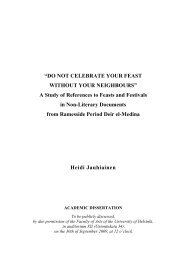BIA
bia51
bia51
Create successful ePaper yourself
Turn your PDF publications into a flip-book with our unique Google optimized e-Paper software.
MARS 2015<br />
Banî Swayf, etc. L’entretien a porté également<br />
sur la possibilité d’organiser une exposition<br />
archéologique islamique en Suisse. (Dînâ ‘Abd<br />
al-‘Alîm, « al-Damâtî reçoit l’ambassadeur de<br />
Suisse », al-Yawm al-Sâbi‘, 9 mars 2015. Voir<br />
également ‘Alâ’ al-Dîn al-Zâhir, « Coopération<br />
entre le ministère de l’Archéologie et la<br />
Suisse », Ruz al-Yûsuf, 9 mars).<br />
- -<br />
Jeudi 12 mars 2015<br />
In 1859, the Frenchman Auguste MARIETTE<br />
found a huge double statue of Amenhotep III<br />
and his favourite queen, Tiye. MARIETTE was the<br />
first director of antiquities in Egypt and<br />
“discovered” famous monuments like the<br />
Serapeum at Saqqâra and the Valley Temple of<br />
Chephren at Gîza.<br />
The statue was found at Madînat Hâbû, the<br />
great temple of Ramses III in western Thebes,<br />
near the Roman Court. But the statue originally<br />
stood at the great southern gate of the<br />
funerary temple of Amenhotep III at Kom al-<br />
Hîtân, to the east of Madînat Hâbû.<br />
When the statue was discovered, many<br />
sections of the figures of the king and queen<br />
were missing and had to be restored by filling<br />
in the gaps. The restoration work was carried<br />
out at the turn of the last century, by an<br />
Italian artist and restorer. He clearly showed<br />
the difference between the original parts of the<br />
statue and the restored portions.<br />
The statue is now housed in the Cairo<br />
Museum, at the end of the main hall on the<br />
ground floor. The king is shown seated, with<br />
his hands placed flat on his knees. Queen Tiye<br />
sits beside him, with one arm placed around<br />
the king’s waist. Between them is a small<br />
statue of one of their daughters, perhaps the<br />
one who married her brother Akhenaton and<br />
was the mother of Tutankhamun.<br />
The most interesting characteristic of this<br />
statue is that the figure of the queen is the<br />
same size as that of the king. This is<br />
considered unusual because a queen was<br />
always shown as being significantly shorter<br />
than a king.<br />
This sculpture shows the power of Queen<br />
Tiye, the beloved of Amenhotep III. He built a<br />
palace and had an artificial lake constructed at<br />
Malkata so he could sail in the royal barge<br />
with his favourite queen.<br />
Egyptologists Hourig SOUROUZIAN and Rainer<br />
STADELMANN are now working at the Kom al-<br />
Hîtân Temple. They have found other huge<br />
standing statues of the king and queen, as well<br />
as of Sekhmet, the goddess of war and<br />
healing.<br />
This has led some scholars to speculate<br />
that Amenhotep III suffered ill health at the end<br />
of his reign, and that the statues of Sekhmet<br />
were intended to help him become well again.<br />
Thanks to the expedition’s good work, the<br />
temple can now be reconstructed, except for<br />
the northern section, where a modern<br />
restaurant and house are located.<br />
The second part of this story began when<br />
the US Agency for International Development<br />
(USAID) funded a project supported by Fâyza<br />
Abû al-Nagâ, the minister of international cooperation.<br />
The project began in 2009 and was<br />
intended to lower the level of the water table<br />
around the temples on the west bank at Luxor.<br />
The team worked under my direction and<br />
was headed by ‘Abd al-Ghaffâr Wagdî and<br />
others. In the course of our work at Madînat<br />
Hâbû, we came away with many surprises,<br />
including the recovery of more than 16 pieces<br />
that appeared to be statue fragments. We then<br />
became detectives, searching for the statue<br />
that the missing pieces had come from.<br />
Because the statue must have been a huge<br />
one, we decided that we should look at two<br />
kings — Amenhotep III and Ramses II. Their<br />
reigns were known to feature colossal statues.<br />
We faced a problem, however, because the<br />
pieces that we discovered were not inscribed,<br />
and they could not be easily dated. But we<br />
had a clue: because some of the statues of<br />
Amenhotep III had been found at Madînat<br />
Hâbû, we began to wonder if these blocks<br />
belonged to the famous double-seated statue<br />
of the king and queen.<br />
This statue was missing many parts when it<br />
was first recovered. Through careful<br />
examination and study, we were able to<br />
confirm that the newly found pieces included<br />
<strong>BIA</strong> LI — Janvier/Juin 2015 59



